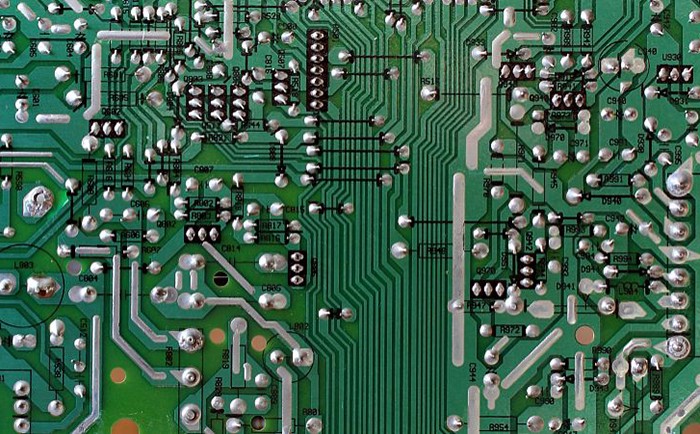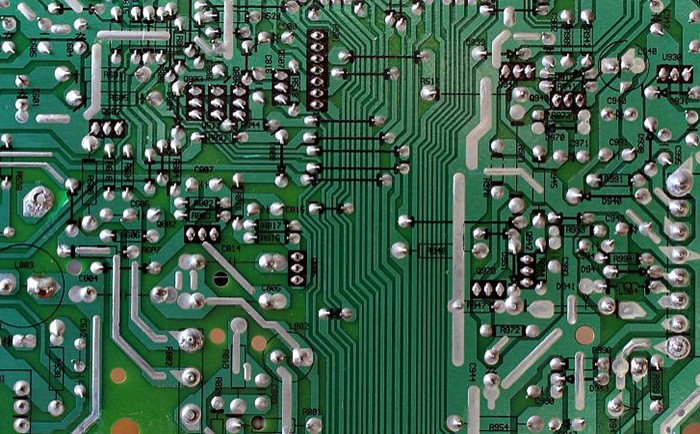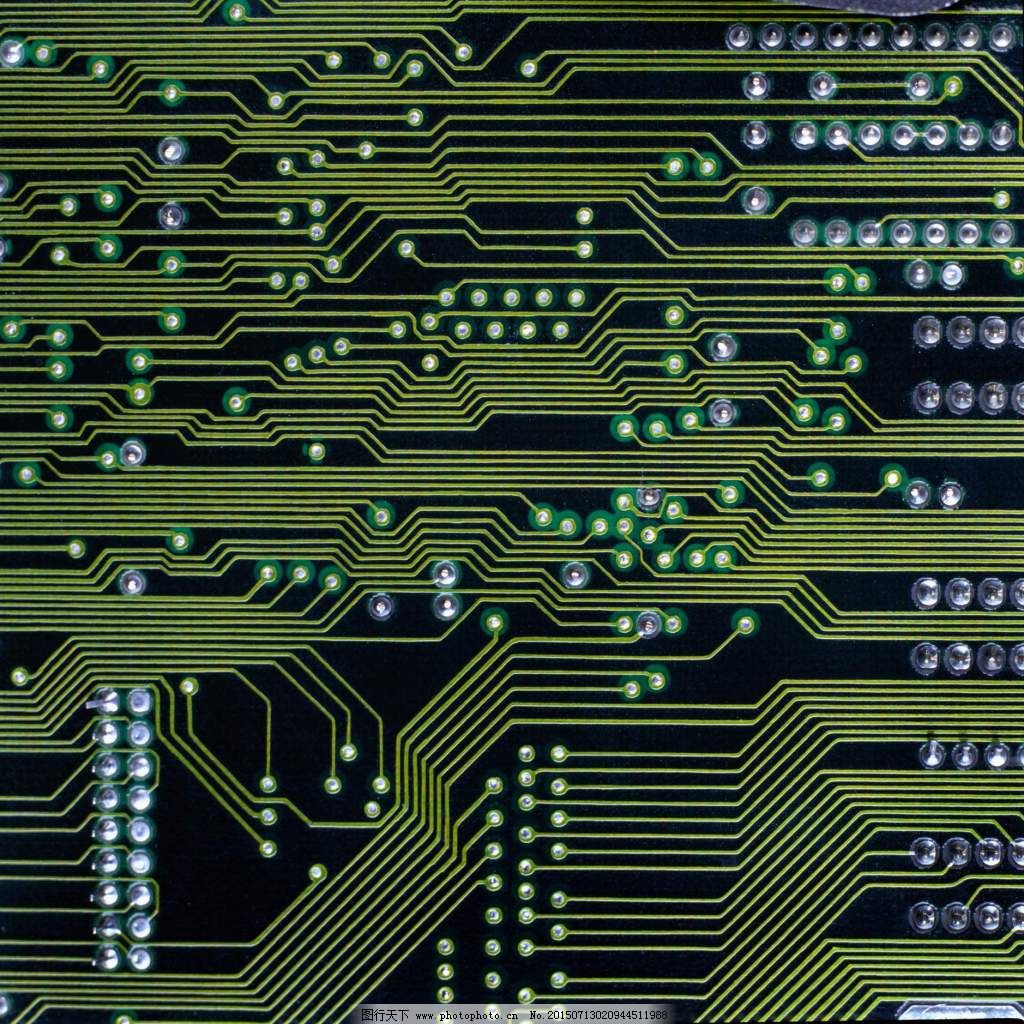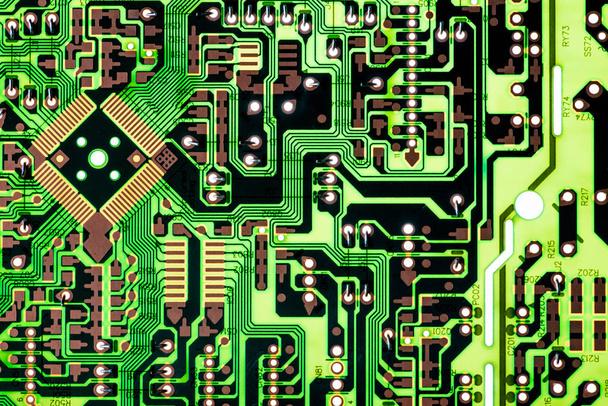
Basic principles of PCB inner layer division
After completing the division of the inner electrical layer, this section introduces several issues that need to be paid attention to when dividing the inner electrical layer.
(1) When drawing the boundaries of different network areas in the same internal electrical layer, the boundary lines of these areas can coincide with each other, which is also a commonly used method. Because in the manufacturing process of the PCB board, the boundary is the part where the copper film needs to be corroded, that is to say, an insulating gap separates the copper films of different network labels, as shown in Figure 11-25. In this way, the copper film area of the internal electrical layer can be fully utilized, and electrical isolation conflicts will not be caused.
(2) When drawing the boundary, try not to let the boundary line pass through the pads of the area to be connected, as shown in Figure 11-26. Since the boundary is the part of the copper film that needs to be corroded during the manufacturing process of the PCB board, there may be problems in the connection between the pad and the inner electrical layer due to the manufacturing process. Therefore, try to ensure that the boundary does not pass through the pads with the same net name when designing the PCB.

(3) When drawing the boundary of the inner electrical layer, if due to objective reasons all the pads of the same network cannot be included, then these pads can also be connected by routing the signal layer. However, in the actual application of multilayer boards, this situation should be avoided as much as possible. Because if these pads are connected to the internal electrical layer by means of signal layer wiring, it is equivalent to connecting a larger resistor (signal layer wiring resistance) and a smaller resistor (internal electrical layer copper film resistance) in series, The important advantage of using a multi-layer board is to effectively reduce the line impedance by connecting the power supply and the ground through a large-area copper film, reduce the ground potential offset caused by the PCB grounding resistance, and improve the anti-interference performance. Therefore, in the actual design, it should try to avoid connecting the power supply network through wires.
(4) Distribute the ground network and power supply network in different internal electrical layer levels to achieve better electrical isolation and anti-interference effects.
(5) For SMD components, pads or vias can be placed at the pins to connect to the inner layer, or from the pins
Lead out a very short wire (the wire should be as thick and short as possible to reduce the line impedance), and place pads and vias at the end of the wire to connect, as shown in Figure 11-27.
(6) Regarding the placement of decoupling capacitors. As mentioned above, a 0.01μF decoupling capacitor should be placed near the chip. For power chips, a 10F or larger filter capacitor should also be placed to filter out high-frequency interference and ripple in the circuit, and use up Possibly short wires are connected to the pins of the chip, and then connected to the internal electrical layer through the pad.
(7) If there is no need to split the internal electrical layer, then you can directly choose to connect to the network in the properties dialog box of the internal electrical layer, and the internal electrical layer segmentation tool is no longer needed.
5 Summary of multilayer board design principles
In the introduction of this chapter and the previous chapters, we have emphasized some principles that need to be followed in PCB design. Here we will summarize these principles for readers to refer to during design, and can also be used as a check when the design is completed. Basis for reference.
1. PCB component library requirements
(1) The packaging of the components used on the PCB must be correct, including the size of the component pins, the pitch of the pins, the number of the pins, the size and direction of the frame, etc.
(2) The positive and negative poles or pin numbers of polar components (electrolytic capacitors, diodes, triodes, etc.) should be marked in the PCB component library and on the PCB board.
(3) The pin numbers of the components in the PCB library and the pin numbers of the schematic components should be consistent. For example, in the previous chapters, the pin numbers in the diode PCB library components and the pin numbers in the schematic library are inconsistent. question.
(4) Components that require heat sinks should take the size of the heat sink into consideration when drawing the component package, and the components and heat sink can be drawn together to form an overall package.
(5) The inner diameter of the lead of the component and the pad should match, and the inner diameter of the pad should be slightly larger than the pin size of the component for easy installation.
2. PCB component layout requirements
(1) The components are evenly arranged, and the components of the same functional module should be arranged as close as possible.
(2) Components using the same type of power supply and ground network should be arranged together as much as possible, which is beneficial to complete the electrical connection between each other through the inner electrical layer.
(3) The interface components should be placed side by side, and the interface type should be indicated with a string, and the direction of wiring should usually leave the circuit board.
(4) Power conversion components (such as transformers, DC/DC converters, three-terminal voltage regulator tubes, etc.) should have enough heat dissipation space.
(5) The pins or reference points of components should be placed on the grid, which is conducive to wiring and aesthetics.
(6) The filter capacitor can be placed on the back of the chip, close to the power and ground pins of the chip.
(7) The first pin of the component or the sign indicating the direction should be marked on the PCB and cannot be covered by the component.
(8) The label of the component should be close to the frame of the component, uniform in size, neat in direction, not overlapping with the pad and via hole, and cannot be placed in the area covered by the component after installation.
3. PCB layout requirements
(1) Power supplies of different voltage levels should be isolated, and power supply wiring should not cross.
(2) The wiring adopts 45° corners or arc corners, and sharp corners are not allowed.
(3) The PCB trace is directly connected to the center of the pad, and the width of the wire connected to the pad is not allowed to exceed the outer diameter of the pad.
(4) The line width of the high-frequency signal line is not less than 20mil, and the outside is surrounded by a ground wire, which is isolated from other ground wires.
(5) Do not wire at the bottom of the interference source (DC/DC converter, crystal oscillator, transformer, etc.) to avoid interference.
(6) Make the power cord and ground wire as thick as possible, and the width of the power cord should not be less than 50mil if space permits.
(7) Low-voltage and low-current signal line widths are 9 to 30 mils, and they should be as thick as possible if space permits.
(8) The spacing between signal lines should be greater than 10mil, and the spacing between power lines should be greater than 20mil.
(9) The line width of the high-current signal line should be greater than 40mil, and the spacing should be greater than 30mil.
(10) The minimum size of the via hole is preferably 40mil in outer diameter and 28mil in inner diameter. Pads are preferred when connecting with wires between the top and bottom layers.
(11) It is not allowed to arrange signal lines on the internal electrical layer.
(12) The interval width between different areas of the inner electrical layer is not less than 40mil.
(13) When drawing the boundary, try not to let the boundary line pass through the pads of the area to be connected.
(14) Lay copper on the top and bottom layers. It is recommended to set the line width value greater than the grid width to completely cover the empty space without leaving dead copper, while maintaining a distance of more than 30mil (0.762mm) from other lines (it can be placed on the copper Set the safety distance before, and change back to the original safety distance value after the copper plating is completed).
(15) After the wiring is completed, perform teardrop treatment on the pad.
(16) External grounding of metal shell devices and modules.
(17) Place the pads for mounting and soldering.
(18) The DRC check is correct.
4. PCB Layering Requirements
(1) The power plane should be close to the ground plane, closely coupled with the ground plane, and arranged under the ground plane.
(2) The signal layer should be adjacent to the internal electrical layer, and should not be directly adjacent to other signal layers.
(3) Separate the digital circuit from the analog circuit. If conditions permit, arrange analog signal lines and digital signal lines in layers and adopt shielding measures; if they need to be arranged on the same signal layer, isolation strips and ground lines need to be used to reduce interference; power supplies for analog circuits and digital circuits Ground and ground should be isolated from each other and cannot be mixed.
(4) The high-frequency circuit has a lot of external interference, so it is best to arrange it separately, and use the intermediate signal layer directly adjacent to the inner electrical layer for transmission, so as to use the copper film of the inner electrical layer to reduce external interference.
6 Summary
Mainly introduces the design steps of multi-layer circuit boards, including the selection of the number of layers of multi-layer boards and the selection of stacked structures; the same and different layout and wiring of multi-layer boards and common double-layer boards; Creation and setup, and inner layer design.







